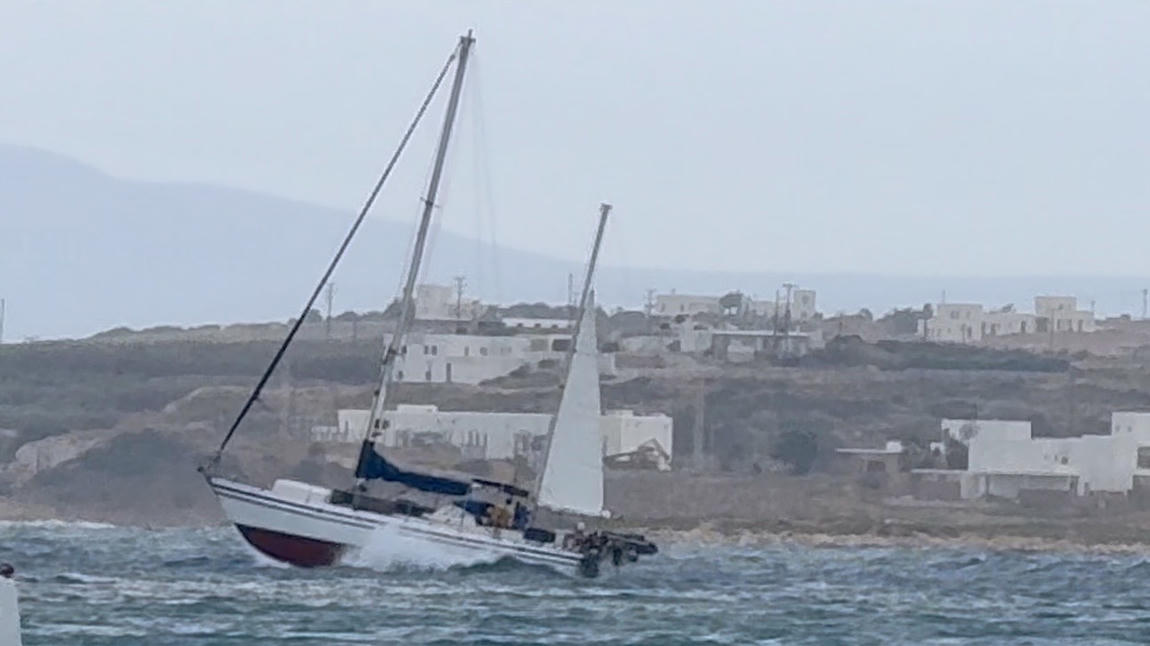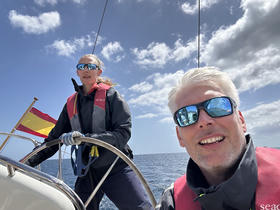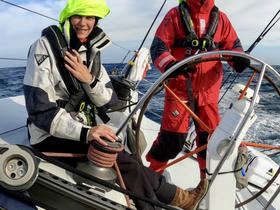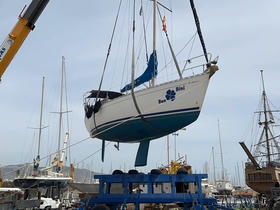3 storms in one day; 24 hours in Paros we’ll never forget
We come to one of our favorite islands in the Cyclades, Paros. Anchored in the north anchorage of Naussa to avoid some strong southerlies, everything is fine - until it isn't.

We've just endured one of the hardest 24 hours we've had on board Bon Bini, probably ever.
The weather has been particularly unsettled this year. There's been a procession of low-pressure systems travelling north-eastward across the Mediterranean, bringing with them strong southerly winds and sand from the Sahara, making the skies an eerie orange.

We use a range of different weather models to help us figure out what weather we can expect. The models are produced by five or so different companies who use a range of different methodologies to predict what will happen, and when. If they all agree, then you can be reasonably sure what you're going to get. And the closer you get to the day, the more likely it is that they will converge. If they disagree, then it's anyone's guess what's in store for you. We tend to take the average prediction and plan for that. Sometimes there are big outliers (either a lot or very little wind), so those we tend to ignore. To make things more interesting with the wind, local land masses can significantly alter the direction and the speed of the wind as it bends around headlands and hills to find its shortest path (to wherever the hell it's trying to get to!).

Yesterday was one of those days when they all disagreed and never converged. Roughly, it looked like we'd get southerlies during the day then, within the space of a few hours, it'd switch to northerlies overnight. This 180-degree shift is always tricky to plan for, as an anchorage protected from the south won't be nice when the wind turns to the north. Lucky for us we're in a big bay in the north of Paros, called Naousa, which has plenty of options.
We were anchored in the south-west corner and set the alarm to get up early for a run before the wind was due to pick up. Not 15 minutes after we got back, it started, and from the south, we were all good. Usually, you try to get as close to shore as safely possible, with the wind blowing off the land, as this can give you the best protection from wind and waves. However, depending on the landscape, it's also where you can get the most severe gusts as the wind falls off the hillside at speed. The shores of this bay are fringed with rocky shelves, which aren't good for the anchor as they need sand or mud to dig into. Being more in the middle of the bay meant we got slightly bigger waves (which sailors call "fetch"), but it was manageable. The sky had an orange glow, and the sun shone weakly through it. We had about 20 knots, which is decent but nothing to be concerned about. We looked at what the neighbouring islands had, and messaged a few friends, and they had nothing! The weather was just with us, it seemed.


At about midday, the wind dropped, and we considered going ashore as we're running low on groceries. Just as we were deciding whether to go, the wind picked up, but this time from the west. Not on the forecast, but probably because it's bending around the hills on the island. Unlike earlier, this time we had 30 knots, with gusts up to 45 knots; the sorts of speeds which start to make things uncomfortable, and a bit scary onboard. As well as things vibrating, rattling and shaking, the boat sails on her anchor. A boat at anchor will always face into the wind as the weight of the anchor and chain out front makes the boat lean away from it. But, as the wind catches one side of the bow, the boat gets pushed sideways until the pull of the anchor centres her again. This makes the boat sail left and right, and the stronger the wind, the more dramatic the boat will lean over as a gust catches her bow. As long as your anchor holds this isn't a problem as the snatch loads aren't so great. It's the waves, though which are the problem. With big waves you're not only moving left and right, but also up and down, which in some cases can "bounce" your anchor out of the seabed.


The bay we were in started filling up as boats came in to seek shelter. It was windy, and we were dancing around but everything was fine. At 1630, again, the wind suddenly dropped. Great we thought, let's dash ashore to get to the shops! So armed with shopping bags we got the engine on the dinghy and went ashore. It was only when we'd walked 3km to get to the supermarket we remembered it was Sunday and everything was closed! Rats! By now, it had started to rain, so we scuttled back to the dinghy armed only with a loaf of yesterday's bread from the one bakery that was open.
We checked the forecast again, and most models agreed we were due to have northerly winds overnight, starting at about 0300. Not fancying moving in the dark, we upped anchor and moved to the northerly bay, which would be protected from the northerly winds. We weren't the only ones with the same idea; there were about six superyachts and another eight or so yachts our size anchored in the big sandy bay. We anchored in absolute calm conditions, made dinner and looked forward to an early night.
At about 1900, and within a few minutes, the wind picked up from the east. Weird, but not a problem for us as there wasn't any land behind us to worry about (also called a "lee shore"). About half an hour later, the direction switched again, the wind was coming from the south. This wasn't ideal for us as now we were on a lee shore, with land behind us. If you've still got enough depth of water under your keel, then this isn't a problem. It only becomes a disaster if your anchor breaks free and you end up on the rocks. Our anchor has always held, no matter the conditions (so far!!), and we have an anchor alarm set on our phone which tells us (using GPS) if our anchor is dragging. We were still fine, but the waves were big as they were being driven from the south into the northernmost corner where we were anchored (the further they travel, the bigger they get). But we were still OK.
At last the wind dropped so at about 2200 we went to bed. An hour later, someone was outside with a flashlight, or so we thought. Bleary-eyed from having just dropped off to sleep, we realised it was lightning. Thunderstorms are never good on a boat, as not only do you have a massive metal pole sticking up but they can bring strong gusty winds with them. You've heard about the Bayesian, I suppose. Most of the thunderstorms we've encountered on the boat have brought a downpour of rain and strong winds, so we were up out of bed with our waterproofs on, just in case.



The rain started to fall, and the wind picked up, from the west this time. We've got a fantastic app on our phones that shows you where the lightning strikes have been, which allows you to see which direction the storm is moving in and how aggressive it is. We could see a band of lightning heading our way, and like the wind earlier, it seemed to only be over our island! The downpour of orange Sahara rain continued and the wind gusted up to 30 knots, making the boat vibrate and everything rattle. At about 00:00, the storm passed, the wind dropped and we headed back to bed. A new forecast had been issued (they update every 12 hours) and it looked like the strong northerly winds would pick up at about 0500, so we could at least get a few decent hours' sleep. We were predicted max. 20 knots, gusting 25-ish. Not crazy.
An hour later, we were woken by a strong gust. Maybe it was just a one-off? We closed our eyes. Then another, and another. The direction was north which was good, but it was only 0100! We peered out of the front hatch and were blasted by a big gust. It was only later that we found out that this bay (like so many others) is notorious for its severe gusts, great. 😬 This is a photo from Navily, taken by someone else, but our experience wasn't far off.

So up we were again. We turned on the wind instruments so we could check the wind speed — we were up to 30 knots already. This wasn't due for another few hours yet. One of the weather apps we use (Windy) reports actual wind speeds from ships and weather stations and there was one in the south of the bay. I looked at it and saw it had reported wind of 32 knots, and a gust of what looked like 11 knots. Seemed low so I zoomed in and to my horror, I realised it actually said 111 knots — hurricane force 12! This freaked us out as this was vastly more than we were expecting. The gusts were very violent now. The roaring wind sent a high-pitched whistle through the rig, a spray of water over the decks and leaned the boat over to one side, so much so that everything on the counter ended up on the floor (our fourth French press of the season was a goner!). The wind speed meter read almost 50 knots. This really wasn't good. I just remember saying over and over, "this is awful". Not helpful!
Then comes the dilemma. Do you up anchor and try to find better shelter somewhere else, or do you stay but risk getting battered? Both can be fraught with danger. Picking up anchor means operating a big winch and steel anchor chain, both of which can easily take fingers off. Plus, it's impossible to hear one another from opposite ends of the boat whilst one is operating the anchor windlass and the other is at the wheel. Even if you get the anchor up with all your limbs intact, you've then got to navigate through an anchorage of heeling and pitching boats in the pitch black and who's to say your Plan B anchorage is any better anyway? Staying put also has its challenges. If your anchor breaks free you're rapidly ploughing through the anchorage like a bowling ball through a set of 10 pins, except every boat you hit doesn't score you points, only a whole heap of grief and insurance paperwork. Even if your anchor holds, anything with any sort of windage risks being shredded or blown away entirely. We decided it was best and safest to stay put until daylight.
We weren't expecting these sorts of winds, so we were somewhat unprepared. Our first mistake was not to have emptied the dinghy of its oars and anchor. Thankfully we always remove the outboard engine after a near disaster a few years ago. We were sitting down below glued to the wind instruments when we heard a weird thud. We ventured outside to find the dinghy had flipped upside down! Now this thing weighs about 50 kg, so it takes some force to upend it. Under the glow of torchlight we watched the oars speed off downwind, and the anchor must have sunk. But, just a few days ago we'd bought a long line so we could more easily tie it to shore, so that line must also be around somewhere? In our panicked, sleep-befuddled minds, this line was now wrapped around the prop, meaning we couldn't start the engine. We took a few deep breaths and remembered the line wasn't a floating one so it should(!) have sunk to the bottom. We righted the dinghy but frankly needn't have bothered as it flipped and righted another three or four times all on its own.
It was now 0230, 3.5 hrs until daylight. The gusts continued and we sat feeling helpless, staring at the wind meter. Our next concern was the bimini, a sunshade zipped over a steel frame. It was flapping furiously in the gusts, but taking it down is difficult even in no wind, so the thought of battling with it in these winds was unimaginable. If it whipped you in the face it'd do some damage. So we decided to leave it to fend for itself, but did venture outside to reinforce the frame with some extra lines.
Our next worry was the anchor snubber, which is a length of line you attach with a hook to the anchor chain to take the strain off the winch. This line was looking a bit dodgy already, and with all the moving around the chance of it becoming damaged was increasing by the minute. We luckily have a backup, so on all fours, we crawled up the deck into the seawater spray to attach it just in case.
It was only 0300, time was on 0.5x speed! There was nothing more we could really do, and there was not a hope in hell of sleeping, so sat in our wet weather gear we (half) watched a movie, Naked Gun, whilst hawk-eyeing the wind (although, it was a bit pointless as it was what it was). We tried to make light of the situation and convince ourselves we'd look back on this whole thing and laugh, but at the time that's difficult to believe. The lack of sleep, the pitch darkness and the not knowing if things will get worse all make it really nerve-wracking. Also too, you can't just "nope out" and get off, you have to sit it out.
We'd got used to the regular noises, but then we heard a different sound. Predictably, it was the bimini. We went on deck to find it flapping violently in the wind, the stitching on the zips coming apart so we had no choice but to dismantle it. Shouting instructions to one another, we managed to get it down without losing an eye, but in the process, Tom's glasses were whipped off his head and into the sea! We dragged the dusty canvas into the cabin, hit play on the iPad and stared at the anchor alarm.
Every 30 minutes or so, we looked out on deck and saw a few boats moving up from the other anchorage. What it must have been like down there for them to move up here, god only knows! We also had the VHF radio on Channel 16 and heard a few of the superyachts calling one another; some went unanswered, and some discussed the horrible conditions.
By now it was daybreak; it was finally getting light. Things always seem less awful in daylight. Tom took the opportunity to get a bit of sleep whilst I was up on deck watching the gusts whip streaks of spray over the water, and a few adventurous boats trying to leave. I realised then that although it was windy as hell, conditions were far better here than they were out in the bay. The waves were huge and the rocks beyond were white with the smashing waves.
Assured we were in a decent spot, and things weren't getting worse, we finally went to bed at 0730 and got a few hours' sleep. We got up at 1100 and made coffee, relieved that our ordeal was over.
Or was it?
As we were in the cockpit, a huge superyacht came in. He drove between us and our neighbour with his anchors dangling in the water. Surely he wasn't going to anchor here?! But yes, surely he was. Just off our bow, and despite our protests, he dropped both anchors. Frantic arm waving ensued, with us signalling he had laid his anchor chain over ours, and he signalling that he definitely had not. There was only one way to find out. Armed with the GoPro I got in the water and lo and behold, he had laid not one, but both his chains over ours. This meant we couldn't leave. We weren't planning to anyway, as we're meeting a friend on a neighbouring island tomorrow, but we might have wanted to. I swam over to the superyacht and told one of the crew, who said he'd tell the captain immediately and come over to us. Yeah, sure. Of course, nothing happened, and no one came, so armed with a photo, and a short fuse, we went over in the dinghy. The captain emerged — Mr Cool, Calm and Relaxed — and assured us there was no way he was over our anchor. Cool, Calm and equally Relaxed Tom suavely produced the photo which visibly shocked the captain, who suddenly couldn't have been more accommodating. Did we want to leave now? Could he help with repairing our bimini, did we need any tools? He said that as soon as we wanted to leave, we should call him and he'd move immediately, day or night. He also told us that he'd come from the neighbouring island, had had no sleep either last night, and that the seas were, "a disaster out there" so he suggested we stay. Not totally enamoured with the thought of not being able to leave when we wanted, but also knowing now that our anchor definitely wasn't going anywhere, we decided to stay put. Back to Bini we went.
 DCIM100GOPROG0013968.JPG
DCIM100GOPROG0013968.JPG 
After a few more hours' sleep, we decided to see if we could mend the bimini, as the thought of being baked by the Greek sun until we could get a new one was not appealing. On further inspection, we realised that it was only the stitching on the zips which had come apart, so the sewing kit came out and we stitched them back on. At 1900, and in need of a much-needed beer, we went ashore to the beach club. We got chatting to the waitress about the weather, and she said that yesterday was so bad they closed the beach club, and she also said that in three seasons of working here, she'd never seen such horrendous wind, so it wasn't just us being dramatic!


I'm sure this isn't the last windy anchorage we'll have this season, but these last 24 hours were certainly memorable! Tomorrow we'll try to retrieve our belongings from the seabed before heading to Naxos.


